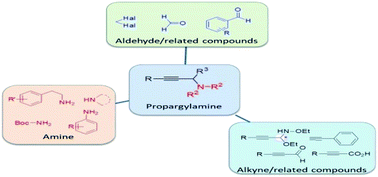Metal-free multicomponent approach for the synthesis of propargylamine: a review
Abstract
Propargylamines are important classes of alkyne coupled amine compounds used in heterocyclic chemistry and pharmaceuticals chemistry and have a large impact as a pharmacophore used in medicinal chemistry. One of the straightforward approaches for the synthesis of this class of compound is A3 coupling, a three-component coupling reaction among aldehyde, alkyne (terminal acetylene) and amine. However, there are many methods other than conventional three component alkyne–aldehyde–amine (A3) coupling which have also been reported for the synthesis of propargylamine. Most of these methods are based on the metal catalyzed activation of terminal alkyne. From the perspective of green and sustainable chemistry, the scientific community should necessarily focus on metal-free techniques which can access a variety of propargylamines. There are only a few reports found in the literature where propargylamines were successfully synthesized under metal-free conditions. This present review article neatly and precisely encompasses the comprehensive study of metal-free protocols in propargylamine synthesis putting forth their mechanisms and other aspects.

- This article is part of the themed collection: 2021 Reviews in RSC Advances


 Please wait while we load your content...
Please wait while we load your content...